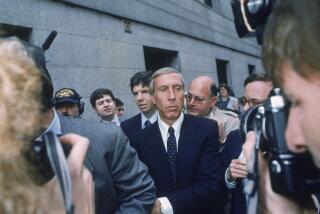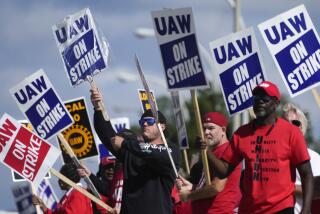The ‘90s Wave of Deal Making May Be Different
The calendar says it’s 1995, but the business headlines of the past week hint of another era: the late 1980s, that now-vilified period of wild wheeling and dealing on Wall Street.
On Monday, IBM launched a hostile $3.3-billion bid for Lotus Development; on Wednesday, machinery giant Caterpillar said it may spend up to $1.2 billion buying back its own shares.
And on Thursday, Aetna Life & Casualty was reported to be in talks with 1980s leveraged-buyout titans Kohlberg Kravis Roberts about a spinoff of Aetna’s property-casualty insurance business.
The backdrop for all of this in many ways resembles what veteran investors remember from 1987-89: Then, as now, corporate profits were soaring, money was easy and business strategy seemed to boil down to eat or be eaten.
The sad outcome of that deal riot, of course, was a rash of major bankruptcies beginning in 1990, along with a stock bear market, the crash of the high-yield junk bond market and a long period of sobering up for the U.S. banking system.
Is it deja vu all over again? It’s tempting to automatically label the current surge in takeovers, buybacks, spinoffs and other financial re-engineering tactics by corporate America an ill-fated mania. But that implies that such binges don’t have to happen--that corporate executives can easily avoid going down this road.
In fact, it’s probably smarter to view this deal-making wave as a natural cyclical phenomenon. The important difference in this cycle, compared with the late-’80s cycle, is that the chief beneficiaries this time seem to be business customers and shareholders, not financiers and a handful of corporate executives.
*
For starters, this deal cycle isn’t about which company can take itself private with the most leverage and fattest payoff package for its top officers. Instead, the driving force behind the 1995 takeover-and-stock-buyback wave is, for the most part, cold cash.
The corporate restructurings of the past 10 years and the economic recovery of the last two years have combined to produce an unprecedented profit windfall for American business. As a result, “many companies are loaded with cash and have to do something with it,” says Gregg A. Jarrell, professor of economics at the University of Rochester’s Simon Graduate School of Business.
“You either have to give it back to shareholders or spend it,” he notes.
For those companies that decide to spend the money, buying other businesses that offer a strategic fit with the acquirer’s own business is a natural course of action.
Much lip service has been paid to this idea of strategic mergers and their potential benefits. Whether they all turn out to be so strategically wondrous remains to be seen. But at the very least, it’s encouraging that the needs of the customer are what’s motivating such deals -- not the financial greed that steered the buy-’em-and-bust-’em-up corporate takeover artists of the late ‘80s.
In the technology business in particular, “the customer wants to simplify his life,” says James Davidson, a managing director at investment banker Hambrecht & Quist in San Francisco. He says that is spurring technology providers to seek partners that fill out product lines (why IBM wants Lotus) or that can provide some other value-added element that might keep customers from looking elsewhere for tech solutions to their problems.
*
For some businesses, however, there may not be a logical new business line in which to sink dollars, or not enough of those opportunities. As cash piles up, the issue then becomes how to return some of those profits to shareholders.
Historically, companies funneled capital back to shareholders via higher cash dividends. That is happening today as well, but many companies are opting instead to use cash to buy back their stock on the open market. The idea is to help drive the share price higher, providing shareholders with a capital gain rather than a cash dividend.
So far this year, announced stock buybacks are running at a record annualized pace of $114.4 billion, according to Securities Data Co.
Critics of buybacks say companies may announce them and never follow through, which is undoubtedly true in some cases.
But failing to follow through is a dangerous game today for a simple reason: Shareholders are paying attention to the growing cash hoards in corporate treasuries and are demanding their fair share. That is what Kirk Kerkorian’s bid for Chrysler was all about. Though that bid has failed, it succeeded in making a point--one which Caterpillar, in announcing its huge buyback, may have understood.
For the investor who remembers the late 1980s, the current deal mania may seem a scary harbinger of a stock market top. But because this wave is more about the customer and the shareholder--at least so far--it’s probably too early to label it wretched excess and fear some terrible outcome.
(BEGIN TEXT OF INFOBOX / INFOGRAPHIC)
Buyback Mania
So far this year, the dollar volume of stock buybacks announced by U.S. companies totals $49.3 billion, a record annualized pace of $114 billion. Value of announced buybacks by year, in billions of dollars:
1995: $114.4*
* full-year estimate, if current pace is maintained
Source: Securities Data Co.
More to Read
Inside the business of entertainment
The Wide Shot brings you news, analysis and insights on everything from streaming wars to production — and what it all means for the future.
You may occasionally receive promotional content from the Los Angeles Times.










